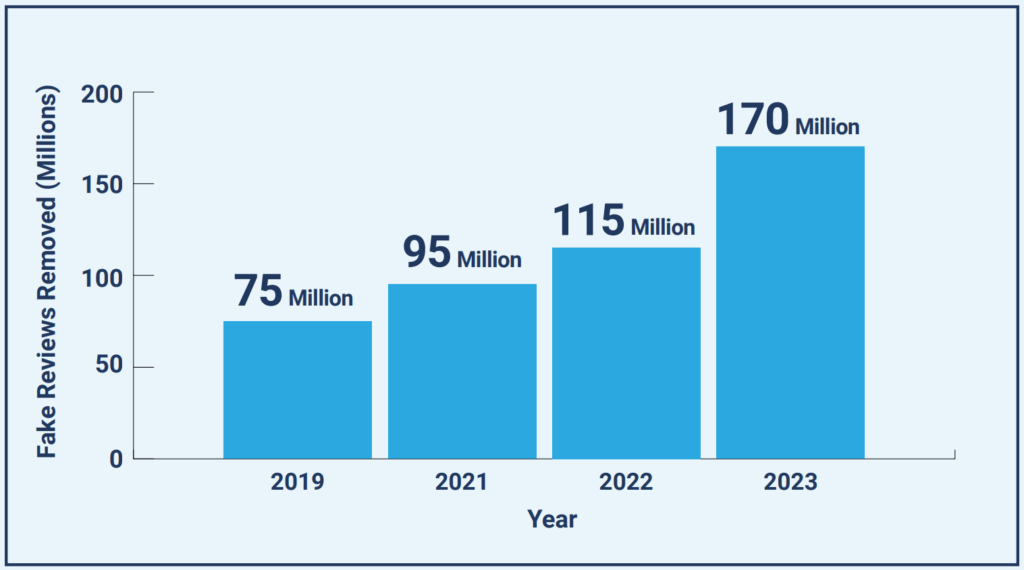December 5, 2024
30 mins read
The High Cost of Review Fraud:
An Economic Analysis of Consumer Harm

The High Cost of Review Fraud: An Economic Analysis of Consumer Harm
Summary of Findings:
- Our economic analysis found review fraud responsible for an estimated ~$300 billion in annual consumer harm – in just these three service sectors alone.
- The average US household suffers $2,385 in annual economic harm, by being misled by suspicious positive reviews that are likely to be fake.
- Ratings and reviews are the single most important influence on consumer purchase behavior; 98% of consumers say they rely on them before buying something.
- Most fake reviews research to date has focused on product transactions. We analyze their impact on three service sectors: Home Services, Legal and Medical.
- We examined 73 million reviews to determine the prevalence of highly suspicious positive reviews on Google in these sectors.
Nearly 14% of the reviews in our data sample were extremely suspicious and likely fake.
- AI Generated Reviews beginning in June 2023 are growing 80% month over month to date.

98%
of consumers say they rely on reviews before buying something

14%

$300 Billion
Introduction: A $300 Billion Problem
This study seeks to quantify the economic impact of online review fraud or “fake reviews” in three major services sectors: Home Services, Legal and Medical. In simple terms, fake reviews are either fabricated or manipulated in an attempt to deceive consumers and the platforms that host them. Fake positive reviews make bad actors more visible online and distort consumer decision-making, steering them toward unethical providers with inferior or fraudulent products and services.
American consumers are being exposed to millions of fake reviews every day1, despite the contrary claims of the main consumer review sites: Google, Facebook, and Amazon. The Transparency Company has documented this.2 And multiple third-party studies have also verified that fake reviews are rampant online.3 When consumers are swayed by fake reviews, they are more likely to choose lower-quality products or services.4 There’s a spectrum of harm the consumer suffers. But in extreme cases, it can be serious or even irreparable: moving companies that hold their customers’ possessions for ransom, doctors who recommend unnecessary surgeries and lawyers who take big retainers and disappear or sleepwalk through trial. At a minimum, consumers deceived by review fraud have probably wasted their money. This is money that would have gone to more honest providers or better products, but for the fake reviews. In some cases, it means spending additional money – sometimes thousands or tens of thousands of dollars – to fix defective or deficient work by an unethical technician or provider. In addition to consumers, fake reviews hurt honest businesses that don’t engage in review fraud. As estimated $300 billion is not just being spent with unethical businesses, but being taken away from ethical businesses. In this report, however, we focus exclusively on US consumer harm.
To estimate the consumer economic harm of fake reviews, we used The Transparency Company’s proprietary technology to analyze millions of reviews in 127 business subcategories that roll up into Home Services, Legal and Medical (Appendix 1). This study evaluated more than 73 million reviews and 62 billion review impressions. Each time a review is viewed it’s counted as an impression. By counting impressions, we believe that these reviews were actually seen by real people. Google is the only review website that publicly displays view count.
We estimate that on average $300 billion in annual consumer spending in these categories is being influenced or “siphoned off” by review fraud. (This is the corresponding injury to honest businesses.) There are roughly 125.7 million households in the United States. Accordingly, each household suffers, on average, $2,385.43 in economic harm annually from exposure to illegitimate positive reviews. Because this is an average, financial damage in individual cases may be much greater.
We hope these findings will make a valuable contribution to policymakers’ awareness of review fraud, its scale and affect on consumers. We want to stimulate debate around policy and regulatory changes to reduce the volume and impact of fake reviews.
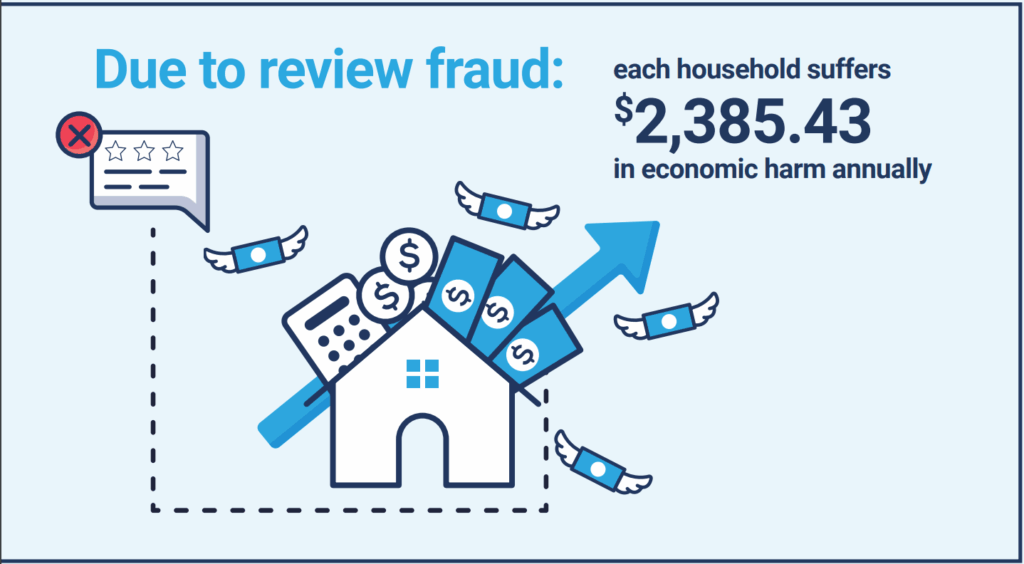
THE POWER OF REVIEWS
Consumers consult online reviews across virtually all product and service categories:
- A 2023 survey5 of more than 1,000 US adults found that “98% of consumers … read online reviews when researching local businesses.”
- Another 2023 survey of more than 8,000 adults found that reviews were critical for consumers: “98% of shoppers say reviews are an essential resource when making purchase decisions.”
Reviews are one of the top two consumer purchase considerations.6 Often they’re the single most influential factor in a buying decision,7 the other is price. This occurs because 91% of consumers trust ratings and reviews; 82% trust them as much or more than recommendations from family or friends.8
It’s no surprise then that online reviews profoundly influence consumer purchases. Consumers are 270% more likely to purchase a product with five reviews than one with no reviews, according to a study from Northwestern University’s Medill Spiegel Research Center.9
The same study showed that reviews have an even more powerful influence on higher priced and higher consideration items. Conversion rates for higher cost items increased by 380% when reviews were present, the study found. That’s because positive reviews build trust and confidence. It’s also the case that consumers often have minimum “star-ratings thresholds” that they want to see before considering a product or service business. Indeed, 64% of consumers won’t consider a business that carries less than a 4-star rating.10 Optimally they’re looking
for ratings in the 4.2 to 4.7 star range.11 They also want to see high review volume12 and recent reviews.13 Google is the largest review platform in the US and is constantly being bombarded by bad actors.
This is not to say review fraud doesn’t exist on other sites across the internet.14 However, Google is the dominant local reviews platform15 and the place most people go to find and read reviews about service businesses.
YOU CAN’T RETURN A SERVICE
Previous research in the e-commerce arena found that “the direct influence of fake reviews on online spending [was] $152 billion globally in 2021.”17 This was for product-based e-commerce only. Product sales, however, represent a minority share of US GDP, which in 2023 was $27.9 trillion, according to the US Bureau of Economic Analysis. Services contribute more than 70% of that total and represent a vastly larger share of US economic activity.
When consumers buy a product because of deceptive or manipulated reviews, they often have some form of recourse. Products can be returned; transactions can also be disputed with credit card issuers. Services are different; you generally can’t “return” a service.
After a substandard or fraudulent service experience, the consumer may have few options or simply be “out of luck.” There may even be an irreparable injury in extreme cases, for example: a doctor who refers a patient for unnecessary surgery.
11 Ibid., Medill Spiegel Research Center
12 PowerReviews, “The Power of Review Volume & Recency,” 2021.
13 BrightLocal, “Local Consumer Reviews Survey 2018,” February 2018.
14 A 2023 report from Fakespot argued that 42 percent of Amazon’s reviews are inauthentic.
15 Ibid., Moz
16 Source is from search on Academic Source Complete, January 26, 2024 using search term “fake online reviews” and manual review of article abstracts.
17 The co-author of the current study, Professor Roberto Cavazos, is also the author of that study, “The Economic Cost of Bad Actors on the Internet: Fake Online Reviews 2021.”
REVIEW FRAUD EXAMPLES: LOCKSMITHS, MOVERS, DOCTORS, LAWYERS
This report generally speaks in terms of high-level data and aggregate numbers. It’s important to recognize, however, that fake reviews have a real impact on real people’s lives. The following examples are just a few out of many thousands that could be illustrated. And while the details of particular scams vary, they all share the fact that fake reviews are the bait used to lure unsuspecting consumers.
Classic Locksmith Scam
One of the earliest fake-review scams involves Locksmiths, which has been going on for years18 and continues today. Typically a “lead-generation” company generates fake business listings and fake reviews for fictional locksmiths. Consumers locked out of their homes or cars search Google and then choose a highly rated locksmith at the top of search results, trusting that the ratings reflect competence and quality. Offshore call centers usually field these calls and quote reasonable prices. The job is then sold or handed off to an unrelated subcontractor whose objective is to increase the price. Once the subcontractor arrives, he typically demands 3x – 5x the quoted cost, usually in cash, after making some excuse for the increase. The consumer almost always complies because of the urgency of the situation.
The average annual cost of locksmith “housecalls” is $115, but can exceed $500.
Price Range for Locksmith Services:

18 See, Wikipedia, Locksmith Scam.
Moving Company Furniture Ransom
Similar to the locksmith scam, unethical moving companies19 will use fake reviews to enhance their visibility in Google search results. Most common in long-haul moving scenarios, these companies initially offer good service and quote reasonable prices during pre-contract interactions with customers. However, once the consumer’s possessions are on the truck they typically say that the weight or volume of goods exceeds the original estimate, necessitating a price increase. They then demand an additional payment, which can be thousands of dollars.20 Upon delivery at the customer’s destination, which is often delayed, the moving company may demand yet another payment, always in cash. The mover retains the customer’s possessions until the extortionate fees are paid, effectively holding them “hostage.” The cost of moving services is dependent on multiple factors but roughly $2,500 on average. Long-haul moving costs can be between $2,700 and $10,000.
Price Range for Moving Services:

Orthopedists and Unnecessary Surgeries
A New York Orthopedist was fined $100,00021 by the NY Attorney General in 2023 after years of buying fake positive reviews and suppressing negative ones on ZocDoc, Google, Yelp and Healthgrades. Among the tactics utilized, the Orthopedist would offer to refund a $50 copay to get patients to take down negative reviews. The Orthopedist also used freelancer site Fiverr to generate fake positive reviews. However, this is not an isolated case; numerous physicians buy fake reviews for their private practices. These often include unethical doctors recommending unnecessary surgeries. In one California case surgery referrals came in exchange for kickbacks22 from a local hospital group. Unlike being overcharged by a locksmith, an unnecessary surgery is an example of a horrific irreparable injury.23
The average cost of an orthopedic surgical procedure is $20,000. Orthopedic office visits and copays can range in price. However, the “cost” of an unnecessary surgery is difficult to estimate and may result in lasting physical and emotional damage.
Price Range for Orthopedic Services:

Rehab Center Deception
In a different medical context, people seeking addiction or alcohol rehabilitation treatment often encounter fake reviews. One such case documented by the Washington Post24 involves a woman who sought an addiction treatment center for her husband. She relied on positive Google reviews to find a center. She placed her husband out of state in a well-reviewed facility in Washington. After the husband completed the 30-day-program, he admitted to his wife that he drank regularly while he was at the rehab center. The woman explicitly chose the program because of positive reviews, later discovered through a third party watchdog that the reviews were fake. The couple’s time and money were entirely wasted.
The average rehab center stay costs: $5,000.

DUI Defense Attorney
There are also numerous examples of lawyers (e.g., DUI defense attorneys) taking retainers from clients, often thousands of dollars, and then either disappearing or providing incompetent representation. In many instances victims are forced to hire a second attorney to clean up the mess. But in cases where a conviction happens, there’s almost no way for the client to be made whole – another example of irreparable injury.
Kay Dean of Fake Review Watch has produced multiple videos on attorneys receiving fake reviews. Her May 2023 video of an Ohio criminal defense attorney with offices throughout the state showed convincingly that the practice was receiving fake 5-star reviews from a network of Google profiles. Dean provided a spreadsheet of 70 Google profiles who had posted 5-star reviews of the Ohio law firm; 25 of those same profiles had posted 5-star reviews of the same Australian hairdresser. Additionally, 22 of those 70 profiles posted 1-star reviews for one of two Vancouver, British Columbia, pet hospitals, showing that these same networks can be weaponized against businesses.
Here’s a link to the video: Objection! Fake Google Review Network Boosts Law Firm, Bashes Animal Hospitals
The average DUI attorney retainer fee is $3,000. Low end is $500, high end is 15,000+
Price Range for a DUI Attorney Retainer:

Google Local Service Ads
Review fraud is also noticeably rampant within the Google Local Service Ads (LSAs) program.25 Introduced in 2015, these ads were specifically designed to simplify advertising but also to help consumers more easily find reputable local service providers. LSAs are now available in more than 75 service categories, and carry a “Google Guaranteed” or “Google Screened” badge intended to instill consumer trust. Google officially says that all LSA advertisers have been vetted and approved, subject to background, insurance and licensing checks. However, review fraud is rampant in LSA ads.26
LSA fraudsters very often use a combination of fake business listings, fake licenses and fake reviews to deceive consumers. In some cases, scammers hijack reviews from other businesses27 to create the appearance of a large volume of positive reviews. Google has made periodic (some would call them token) efforts to confront LSA review fraud. But they have not been consistent and have largely been unsuccessful addressing this systemic problem. As one example, many unethical HVAC-duct cleaning businesses use LSAs.28 Similar to the locksmith scam, there’s typically an offshore call center, an attractive price quote and an unrelated subcontractor who does the actual work.
That subcontractor often shows up in an unmarked van and announces that the particular job will cost more than the original quote (very often $99).
The new demand can be up to 10x what an honest duct-cleaning company would charge. Sometimes shoddy work is performed, sometimes no work happens, which the homeowner only later discovers.
These scams rely on fake or “hijacked” reviews to boost the visibility and credibility of their LSA ads. They outbid legitimate businesses and sell the leads to unvetted subcontractors who overcharge consumers. This hurts both consumers and legitimate business owners, who are overshadowed on Google by these fraudsters.
User research has found that consumers click on LSAs specifically because of positive reviews and the Google Guarantee badge. When they appear in search results, LSAs “divert” traffic that would have otherwise gone to legitimate business listings.29 Google’s sporadic attention to LSA review fraud, together with the Google Guaranteed “endorsement” of these fraudsters, makes the company an enabler of consumer deception in this context.
Google has few incentives to crack down on review fraud in LSAs or otherwise on its properties. That’s because it’s insulated from liability under Section 230 of the Communications Decency Act, which provides immunity30 to online platforms for third-party content, including usergenerated reviews.
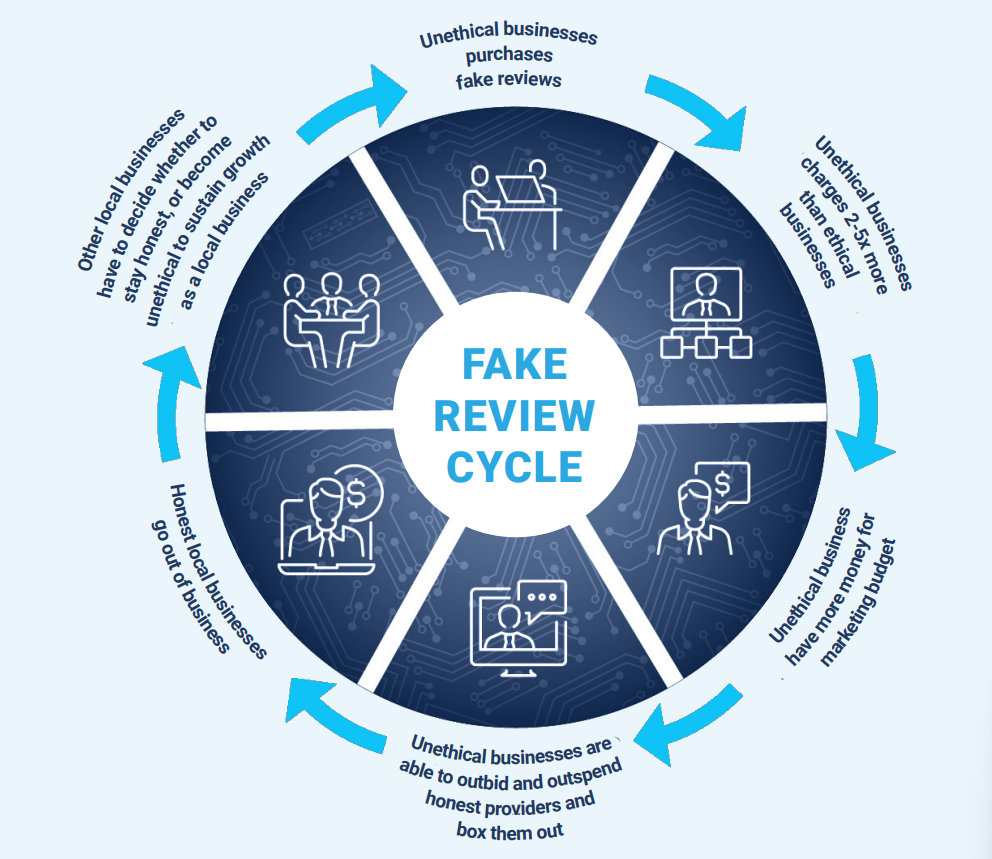
AI-Generated Suspicious Reviews
A new phenomenon in the world of review fraud concerns the application of generative AI to create or assist in the creation of fake reviews. The Transparency Company partnered with AI text detector Pangram Labs31 for this part of the analysis.
We determined that 3.1% of reviews in our dataset were produced by AI or with the aid of AI; ~2.5% of those were written for businesses with multiple red flags. For example, these business profiles had multiple AI generated reviews and other tell-tale signs. Roughly 0.6% of the dataset appear to be reviews by humans using AI to help them. In this second scenario we saw fewer other AI reviews per profile, yet the content of the reviews in question suggest AI assisted-authorship of a genuine experience.
Accordingly, we have a high degree of confidence that 2.3 million reviews in the dataset are partly or entirely AI-generated.
Pangram Labs identifies several factors that it calls “AI tells.” Among them are the following:
- Review length – longer reviews are often an AI signal
- Empty descriptors – generic phrases and attributes
- Cliches – “the first thing that struck me,” “game-changer,” “delivers on its promise” “without the fuss” and so on.
- The review repeats the prompt – such as the full product name or formal business name
- Highly structured writing – often including an introduction, bullets and/ or summary

We started to see AI reviews in mass beginning in June 2023, growing 80% month over month to date.
Below are a few verbatim examples of suspicious reviews from the analyzed data. They all appear excessively formal or otherwise inauthentic. As one example, all use the phrase “I recently had the privilege”; another cluster uses “I recently had the pleasure.” In isolation these phrases and their reviews might not appear suspicious, but when compared at scale Pangram Labs flags them:
Business: Anonymous Chiropractor
Time of Review: November 2023
Business: Anonymous Law Firm
Time of Review: January 2024
Review Text: ”I recently had the privilege of working with Amy at (Redacted Company Name) . She was compassionate, knowledgeable, and incredibly supportive throughout the entire process. Her guidance made a difficult time much easier to navigate, and I’m grateful for her expertise.”
Business: Anonymous Law Firm
Time of Review: January 2024
Review Text: ”I recently had the privilege of working with (Redacted Company Name) for my legal needs. The team was professional, thorough, and attentive to every detail. Their dedication to my case resulted in a favorable outcome, and I couldn’t be more thankful for their hard work.”
It’s almost impossible to read these reviews together and not come away with the sense that they’re inauthentic. Pangram Labs isn’t using intuition, however. It uses an algorithm looking at multiple signals and doesn’t flag reviews without a high degree of confidence.
Here’s a longer example for a residential contractor:
Review Text: “I can’t say enough about the exceptional work that (Redacted Company Name) delivered for my project. From the very start, their professionalism and attention to detail stood out. The team’s dedication to understanding my vision and turning it into reality was truly impressive. (Redacted Company Name)’s expertise in every aspect of the project was evident. They seamlessly managed the entire process, from planning and design to execution and completion. Their craftsmanship and commitment to quality were evident in every corner of the work they did. What really stood out to me was their exceptional communication throughout the project. I always felt informed about the progress and any developments, which gave me great peace of mind. They were open to my suggestions and concerns, making me feel like a valued partner in the process. The end result exceeded my expectations. The attention to detail, the precision in execution, and the level of care they put into their work truly transformed my space into something remarkable. I can confidently say that (Redacted Company Name)’s work has added not only value but also a touch of elegance to my property. If you’re looking for a construction company that delivers on their promises, goes the extra mile, and produces outstanding results, (Redacted Company Name) is the name to trust. Their team’s professionalism, skill, and dedication are unparalleled. I’m genuinely grateful for the incredible work they’ve done and wouldn’t hesitate to recommend them to anyone seeking top-notch construction services.”
Among other “tells,” the generic quality of the description and the repetition of the company name (four times) are suggestive of AI. This review is designed to appear highly detailed and thorough, but it’s largely devoid of substance and full of cliches. Consider, for example, “I can confidently say that (Redacted Company Name)’s work has added not only value but also a touch of elegance to my property. If you’re looking for a construction company that delivers on their promises, goes the extra mile, and produces outstanding results, (Redacted Company Name) is the name to trust.”
This doesn’t sound like a real person; it sounds like an AI seeking to imitate a real person’s review but doing it in a more formal and largely generic way.
WHY THEY CHEAT: FAKE REVIEW INCENTIVES
Why do businesses engage in review fraud? If the answer isn’t selfevident, the most common scenario involves businesses generating fake reviews for themselves to improve their search rankings and revenues.
They sometimes write their own reviews using fake profiles or ask employees to. They may use reputation contractors or buy fake reviews from offshore review farms.32 They can also source fake reviews in Facebook or WhatsApp groups. And, as indicated, businesses and review fraudsters are increasingly turning to AI tools.
Regardless of the specific method, business owners typically invest in fake reviews to increase ratings and review volumes. Better ratings and more reviews is what the vast majority of consumers want to see. They also boost search rankings on Google – reviews are an explicit local ranking signal33 – and increase consumer trust and purchase intent, as mentioned.
Research by the National Bureau of Economic Research (NBER), for example, discovered that a single point increase in hotel ratings leads to a 6.5% percent increase in consumer demand and, subsequently, a 1.5% increase in prices.34
A Harvard Business School study35 found that “a one-star increase in Yelp rating leads to a 5% – 9% increase in revenue for independent restaurants.” Businesses with better reviews typically see a meaningful uptick in sales. They can also command higher prices.
The 2023 edition of the annual Local Search Ranking Factors study36 revealed that “High Numerical Google Ratings (e.g. 4-5)” is the top driver of consumer conversions (business contacts, transactions) on a list of nearly 100 variables. Businesses understand these market dynamics and their importance. They’re also perpetually told by professional marketers, quite accurately, that better online ratings directly translate into revenue.
REVIEW FRAUD DETECTION
Review fraud isn’t limited to buying fake positive reviews. Businesses also buy or generate negative reviews to harm competitors. Scammers also engage in “review extortion,” posting negative reviews on a business’ profile until they’re paid off by the owner. In other words, there’s a spectrum of review fraud and abuse. But whatever the specific intent behind fake reviews, The Transparency Company’s detection methodology is the same. We use content analysis and profile behavioral analysis to hypothesize whether reviews are real or fake, on real or fake user profiles.
The Transparency Company uses more than 170 different signals to determine whether an individual review may be authentic. The following are only a few of the considerations used to identify and score questionable or suspicious reviews.
36 Whitespark, Local Search Ranking Factors, March 2023.

Authorship Style Analysis (NLP): Detecting reviews written by the same person.

AI Detection: Identifying reviews generated by popular LLM’s and AI assistants.

Sentiment Analysis: Identifying exaggerated sentiment, including excessive use of exclamation marks.

Content Matching: Searching for phrases that align with content from employees, family, or friends.

Duplicate Reviews: Identifying reviews hijacked from other businesses.
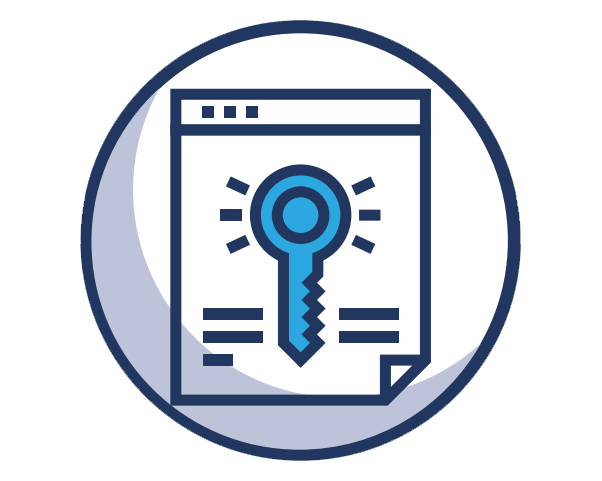
Keyword Analysis: Identifying instances of keyword stuffing.
Behavioral Analysis:

Review Pod Analysis (RPA): Identifying groups of contributors writing for the same businesses.

Distance Matrix Analysis (DMA): Measuring distances between reviewed businesses from the same contributor.

Time Pod Analysis (TPA): Analyzing the timing between reviews from the same contributor.

Outlier Detection – Turkey in the Straw (TIS): Identifying incongruent review patterns among contributors (e.g., locksmith review alongside coffee shop and local park reviews).

Anonymity Analysis (ANON): When a contributor’s profile is anonymous.

Low Profile Engagement (LPE): Contributors who have only written one review.
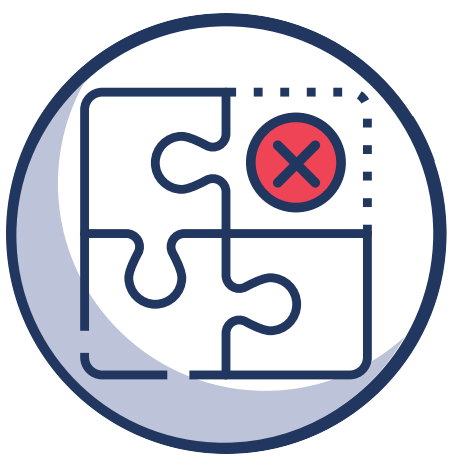
Contributor Mismatch (CMM): When visible reviews do not align with the contributor’s reported activities.

Timeline Analysis (TLA): Examining the frequency and pattern of review submissions.
From this analysis we sort reviews into three broad categories:
- Real: high confidence that a review is authentic
- Moderately Suspicious: high probability the review is fake based on our flags that we’ve identified using our technology.
- Extremely Suspicious: extremely high confidence that a review is fake based on red flags while analyzing the reviews with our technology.

Data Sample: 73 Million Reviews
The three major service sectors examined in this study together account for trillions in annual spending in the US. These three sectors contain 127 subcategories (Appendix 1). Across all subcategories, we analyzed approximately 73 million reviews, which generated more than 62 billion review impressions (i.e., the reviews were actually seen). The review data was from 100 US cities. Out of 73 million reviews, we determined 7.6 million were extremely suspicious and 12 million were suspicious. Accordingly, 10 million of the 73 million reviews (13.7 %) were actually or highly likely to be inauthentic.
Across three service sectors:

73 million reviews were analyzed

62 billion impressions

13.7% of reviews were actually or highly likely to be inauthentic.
UNDERSTANDING THE DATA
Academic research on review fraud has noted the paucity of data for enabling detection on a large scale. Some researchers have noted, “There are a handful of datasets for fake review detection, but each of these comes with its own difficulties”37 Data for frequently-cited research has largely been obtained from China or surveys from very small data sets.
The volume and quality of the data used in this study is made possible by the development of proprietary technology and techniques to capture and identify suspicious reviews at scale. In addition to our ability to generate economic harm estimates, our data can be used broadly, in a variety of types of research. And because of the available scale, Transparency Company data can generate a new and more robust understanding of the issues surrounding fake reviews across research and policy domains.
In addition to determining economic harm, the data can also be used to examine the prevalence of fake reviews in specific geographic locations and particular industries or occupations. It can answer many other questions as well. This type of research can provide insights into consumer behavior, as well as the prevalence of unethical conduct in certain occupations among other possibilities.
37 See: Salminen et al. Journal of Retailing and Consumer Services, Volume 64, January 2022
DATA UTILIZED:
- Category: These encompass the three sectors: Home Services, Legal and Medical. (Refer to the appendix below.)
- Percentage of Fake Reviews: This represents the proportion of fake reviews identified among all reviews. The characteristics and origins of these reviews are such that they are conclusively identified as fake. These were detected using the methods described in the review fraud detection methodology section above.
- Percentage of Suspicious Reviews: This represents the proportion of reviews that exhibit characteristics which are suspicious but not conclusively fake.
- Average Number of Reviews: This indicates the average number of reviews for each business category.
- Total Reviews Analyzed: This is the aggregate number of reviews analyzed for each business.
- Average Impression Count per Review: This metric indicates the average number of impressions generated by each review.
DERIVED ESTIMATES:
- Estimated Impressions Consumed: This is calculated as the total number of reviews multiplied by the average number of impressions per review.
- Estimated Consumers Consuming Reviews: This figure is derived by dividing the estimated impressions consumed by the average number of reviews consumed per consumer, yielding the estimated number of consumers. The number of reviews per consumer is inferred from available data.
- Estimated Consumers Consuming Fake Reviews: This estimate focuses on the number of consumers exposed to or influenced by fake reviews.
- Annual Cost of Service: This represents the yearly cost of services, derived from public sources (e.g., AMA, ADA, NOLO, Angie’s List).
The economic costs of review fraud, and corresponding consumer harm, are a function of impressions consumed, estimated consumers viewing reviews generally, estimated consumers consuming fake reviews and the annual cost of service. In addition, we include the rate at which consumers “convert,” which is the average percentage of consumers who actually obtain the service.
FAKE REVIEWS AND INFORMATION ASYMMETRY
One of the primary functions of online reviews is to provide more information to buyers. In this way, reviews help overcome “information asymmetry,” an economics term that refers to an informational imbalance between parties to a potential transaction.
Reviews give consumers experiential insights that might otherwise be hidden from them, helping them (in theory) make more informed choices between competing services, whether locksmiths, dentists, HVAC technicians or restaurants.
But that important function is disrupted or corrupted when roughly 14% of the reviews consumed are polluted by fraud. Rather than overcoming asymmetry, fake reviews make it worse and create new asymmetries. Product or services attributes and quality are not accurately portrayed in fake reviews. The buyer confronts misleading or incomplete information, and makes a purchase decision they would not otherwise have made – choosing a locksmith who overcharges, an incompetent mechanic, a less desirable hotel room, and so on.
A November 2023 study38 from NBER confirms this. Consumers influenced by fake reviews are more likely to purchase lower-quality products. The study calculated the consumer economic harm was up to $0.12 or 12% for each dollar spent. This was even more true for more frequent online shoppers.

Direct economic harm comes from choosing lower low quality services or fraudsters. As we’ve indicated, indirect economic harm is also suffered by honest service providers. Ultimately, the prevalence of fake reviews will lead to an erosion of trust in online reviews and related information, which imposes additional costs on consumers and businesses.
38 See: The Impact of Fake Reviews on Demand and Welfare Jesper Akesson, Robert W. Hahn, Robert D. Metcalfe, and Manuel Monti-Nussbaum NBER Working Paper No. 31836 November 2023
CALCULATION OF ECONOMIC HARM
Our approach to estimating consumer harm is below. We use a relatively straightforward model to estimate costs. Here we supplement Transparency Company review data with information from outside sources (i.e., consumer spending data). Assumptions of demand elasticity and purchase probability are also provided.
The harm done by fake reviews to service buyers may be more significant than to product purchasers, as we’ve argued. Many of the services on our list are crucial to health and well-being.39 The non-economic impact of fake reviews can include inconvenience, anxiety and
ELASTICITIES OF DEMAND
The services we examined have different demand elasticities as well as temporal elasticities. In other words, some of these services typically carry greater urgency, such as the need for a locksmith or plumber to unclog a toilet. Some needs and business categories will involve more diligence or be pursued at a more relaxed pace. Accordingly, we assume different elasticities for the three major sectors analyzed.
We operationalize elasticity by looking at the number of impressions consumed. This also yields the number of consumers who read reviews. In some use cases and categories people will read more (or fewer) reviews over a longer (or shorter) period of time. Consumers will typically read more reviews for a high-consideration purchase, such as choosing a primary care doctor or an estate planning attorney, than they do when choosing a restaurant or self-storage facility. Obviously, some of the specific services within each of the three sectors will differ in terms of the number of reviews read and the urgency of the decision. We have used averages across sectors. We assume that where more urgent consumer needs exist, reviews (and fake reviews) will have an even greater impact on purchase decisions.
39 The determination of the differences in economic harm due to fake reviews of products compared to fake reviews of services is not only an academic one, but substantive, as regulatory and educational interventions would differ between the host of products and services.
CONVERSION ESTIMATE
The data shows that of the three categories, Medical services saw the highest average number of reviews consumed. That was followed by Legal and then Home Services.
We also assume each review has some effect on purchase intent. However, our data shows that, across sectors and categories, each review seen by an in-market consumer has a .011% probability of influencing a purchase.
ECONOMIC MODEL
The equation we used to derive economic harm for this study is straightforward:
Y = Economic Costs/Harm
B = Annual Cost of Service
A = Fake Reviews Consumed
P = Probability of Purchase by
using reviews
Y = (B)*
((A)*P))
For example, a consumer seeking a plumber will search and find listings for numerous plumbing businesses online. If they were to look, hypothetically, at 100 reviews – of which 27% or 27 were fake – there is a 27% probability their purchase of $1,000 worth of plumbing services would be influenced by the fake reviews.
RESULTS: $300 BILLION AND COUNTING
Using this methodology, we found that the total annual consumer economic harm from exposure to fake reviews in Home Services, Legal and Medical ranges from a low of $273 billion to a high of $334 billion, with an average of ~$300 billion. Here’s how they break down by sector:
Consumer Harm Break Down By Sector

The underlying data cover the period from February 1 2023 to February 1 2024. The range estimate incorporates variability in the probability of fake review influence on consumer purchases, varying by + or – 10% from our average conversion estimate.
It’s important to recognize that $300 billion in consumer harm only reflects transactions in three industries. An analysis of more sectors would undoubtedly yield larger numbers.
REDUCING REVIEW FRAUD
1
Consumer education: Consumers need to understand the full danger of fake reviews and how to spot them. Free tools are available to protect them from fake reviewers, and other methods of due diligence can help identify other red flags
2
State enforcement: Individual states could perform review fraud analysis as part of licensing or licensing renewal processes for in-state businesses. Businesses that cross a threshold number of fake reviews would be disqualified or penalized in a meaningful way. This would create a disincentive to buy or generate fake positive reviews.
3
Review compliance technology: Involving a sophisticated and reliable reporting system that works at scale to hold tech companies accountable with fake review detection and moderation. Using advanced algorithms to detect synthetic review behavior, this layer of protection would prevent black-hat users from circumventing review platform fraud detection.
4
Universal digital ID: This would effectively be a “consumer authentication token,” for use by platforms as a way of identifying authors of review content. There would be privacy concerns and potential for abuse. But by having consumers opt-in to maintain a digital identity, those issues could be managed and it would be easier to authenticate reviews.

BUILT THE ECONOMIC MODEL USED TO ESTIMATE HARM:
Roberto Cavazos
Dr. Cavazos is Clinical Associate Professor of Information Technology and Decision Science at the University of North Texas. He has written and published peer reviewed articles, government reports, and two books. His research has been cited by the Federal Trade Commission in Congressional Reports. In addition, outside of academia, he has a career as consultant and expert for Federal Government Agencies, law firms, NGO’s and Fortune 500 Companies.

Greg Sterling
Contents
- Summary of Findings
- Introduction: A $300 Billion Problem
- The Power of Reviews
- Review Fraud Examples
- AI-Generated Suspicious Reviews
- Why They Cheat: Fake Review Incentives
- Review Fraud Detection Methodology
- Data Sample and Analysis
- Economic Impact: $300 Billion in Consumer Harm
- Reducing Review Fraud
- About the Authors
Want to work with us? Reach out today!
Top 5 Business Categories Impacted:
Home Services, Legal and Medical Industries
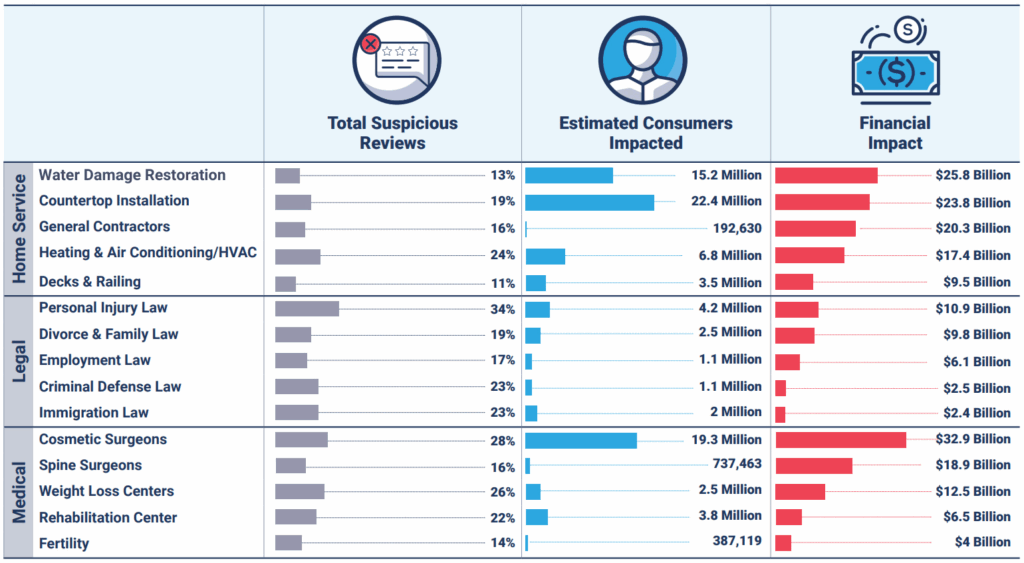
Reviews Removed on Google Maps:
2019 - 2023
